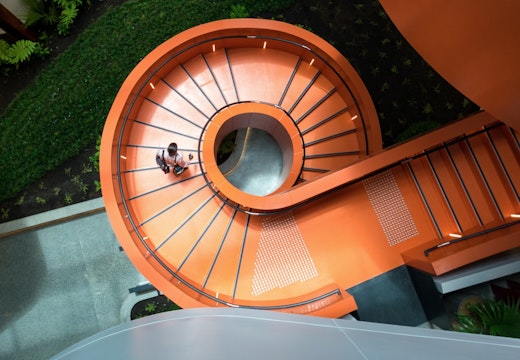Desks on the move: a suitable case of social contagion?
A new system in BVN’s design studio means workers can now roll their desks to a new location at will. What will this mean for social learning and changing behaviours?
Last week I exercised my rights of free agency and personal empowerment by unplugging my desk from the octopus it was tethered to and rolling it across the studio to the spot previously occupied by a colleague. It took about three minutes to link to a shiny new octopus and – voila – I became a member of a new team.
Since the name is less than self-explanatory, an octopus is part of BVN’s boom and octopus combination that allows each of us to reconfigure our studio environment at will. All desks are on wheels and both power and data drop from fibre optic cables nestled in overhead circular booms that connect to a host, or octopus, which supports up to eight desks.
Extreme flexibility
Why move desks rather than people, you ask. Isn’t that somewhat hypocritical coming from people known for promoting alternative working? The answer is poor performance of software programmes like Revit, V Ray, Rhino or Grasshopper over wi-fi. No, I’ve not upskilled personally, but there are others at BVN who are far more talented and unburdened by technical challenges than I who’d be crippled without the boom and octopus solution.
For organisations like BVN, extreme flexibility opens many doors. Some, like enabling teams to reorganise, are fantastic; others are a work in progress. For example, we’re currently drafting guidelines that clarify when and how one can roll, otherwise to quote our office manager ‘it would be a real shit show’. And even though you would think it unnecessary to remind architects not to park their desks in fire exits or blocking loo doors, the guidelines will dictate exactly where you can stop rolling.
Tracking desk movement
In parallel, we’ve embarked on a research project intended to track desk movement. This is critical since a successful rolling studio will inherently rely in part on human nature. We all know that just because an individual has the right to roll, it doesn’t mean they will. The psychological aspects of rolling we might explore are plentiful. What inspires one to roll while others are happy to stay still? Do some people have roll phobia? Is the fear of recrimination due to changing location real?
We also wonder whether people will learn anything from rolling. Perhaps some will become roving studio journeymen, or roll to locations where they’ll amass skills or positive behaviours via osmosis? The hypothesis could be tested on me. We can take note if I’ve become more hip sitting next to Sebastian who is a wiz at photoshop, or if being in the mere vicinity of Selina encourages me to learn Revit.
Social contagion
It’s not as crazy as it sounds, particularly if you know anything about social contagion. I recently learned about this theory listening to an interview with Dr Gary Slutkin, a physician and infectious disease control specialist at the University of Illinois, Chicago. He knows plenty about spreading things.
Slutkin also happens to live in a city where the murder rate surpassed 1,400 in July 2018. He is therefore well placed to pursue his vocation of studying infectious disease along with his other passion, the spread of crime. Cure Violence is the programme he founded that’s being rolled out across cities in the US. It marries both spheres of Slutkin’s expertise and led him to suggest the spread of violence through a community happens in the same manner as a contagious disease.
Take something nasty like Ebola – your chances of contracting the disease increases with exposure and the disease spreads quickly or slowly depending on specific factors: age, overall health and living conditions. With violence, the factors are exposure to gang wars, riots or childhood abuse. The evidence that Slutkin has amassed contradicts the common belief that violent acts are random. Instead, he suggests it follows the patterns of contagion and both disease and violence cluster in time and space.
Behaviours spread rapidly
Social science has reached similar conclusions about behaviours. Attitudes, beliefs, and behaviours move through populations. Like infection, they spread rapidly and are often accepted uncritically. Given the human condition is a combination of both a biological and social process, and each rely on replicated instructions, you can start to see the connection. In biology, a gene is reproduced; in social processes, it’s a meme, or culture.
It’s called social contagion, it applies to both good and bad behaviours and the concept is by no means new. In 1774 Goethe’s publication The Sorrows of Young Werther inspired so many people to commit suicide that both the book and Werther’s clothing style were banned. The Werther effect is now a synonym for media-induced imitation.
Social learning theory posits we learn social memes and behaviours by directly experiencing, observing and imitating – and by making cognitive inferences based on our observations. Back to our studio, based on the theory of social learning and contagion, it is entirely plausible that I might develop new skills because of where I roll my desk to – or at least adopt an attitude or aptitude to learn.
Of course, we must be mindful not to spread bad behaviours. The research says this can be minimised by limiting exposure or inoculating people against the effects. Currently the only really bad thing that I can think of that could infect the studio would happen at the Christmas party when the New York crowd comes over. As far as I know there is no inoculation against stupid and our colleagues do live in the same city as the Trumps and may be infected. We should be thankful to have no office in Canberra.
Sources
Bushman, Brad J. PhD, ‘How Violence Spreads Like a Contagious Disease’ Psychology Today, May 31, 2017
Niederkrotenthaler T, Herbert A, Sonneck G. ‘The “Werther-effect”: Legend or Reality?’ Neuropsychiatry 2007; 21(4)
Jack, B; ‘Goethe’s Werther and its effects – The Lancet Psychiatry’, The Lancet, April 30, 2014
Marsden, Dr. Paul, ‘Memetics & Social Contagion: Two Sides of the Same Coin?’ The Journal of Memetics: Evolutionary Models of Information Transmission, 1998 Vol 2.
Slutkin, Gary MD, ‘Violence is a Contagious Disease’, National Academies Press (US); 2013 Feb 6. II.9, Available here
‘How Treating Violence As A Disease Could Help Prevent It’, Here and Now, PRI WBUR, March 22, 2017








